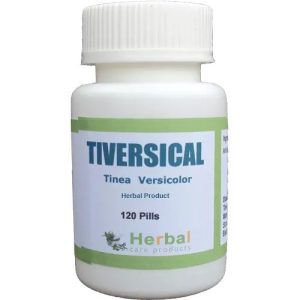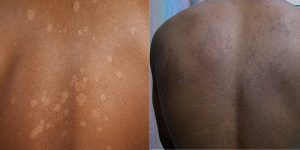No products in the cart.
Return To Shop 0 Cart $0.00 0
No products in the cart.
Return To Shop Shopping cart (0)
Subtotal: $0.00
Free shipping over 299$
Is Tinea Versicolor the same as Eczema?
Introduction
Tinea versicolor and eczema are two common skin conditions that cause small red bumps on the skin. Both of these conditions can affect people of any age, but they tend to affect younger people more often than older people. Tinea versicolor is caused by a fungus called Malassezia furfur, while eczema is caused by bacteria or an allergic reaction. People who get tinea versicolor don’t usually notice any symptoms until their condition progresses or becomes worse–but some people may experience itching, sweating or other symptoms before their first case shows signs of infection.

Tinea versicolor is often confused with eczema.
Tinea versicolor and eczema are two different conditions. Tinea versicolor is caused by a fungus, while eczema is caused by a virus. The difference between the two conditions can be difficult to see if you’re not familiar with them both, but it’s important to know the difference because they affect people differently in different ways!
If you have tinea versicolor on your skin and you want to treat it but aren’t sure which method will work best for you, here are some tips:
Related Articles: How to Identify Tinea Versicolor: Signs, Symptoms, and Solutions
Both tinea versicolor and eczema are skin conditions that cause small, raised, red patches on the skin.
Tinea versicolor is caused by Malassezia furfur and eczema by a different fungus called Trichophyton rubrum.
Tinea versicolor typically affects younger people, while eczema tends to affect older people.
Tinea versicolor is typically a skin condition that affects younger people. Eczema, on the other hand, typically affects older people.
Tinea versicolor can be caused by mite or fungus infection and usually appears on the face or arms. It tends to be milder than eczema but can still cause itching and irritation if left untreated. Eczema tends to occur more often in children under 12 years old who have dry skin or sensitive skin types (like those who get eczema from allergies). People with oily skin may also develop tinea versicolor due to excessive oil production from their pores which makes them more prone for infection from mites or fungi living within their pores.

People with tinea versicolor often have a mild case of their condition, which can be treated at home.
- Tinea versicolor is a fungal infection that affects the skin and nails. This condition can be treated at home, but if you develop severe symptoms, you may need to see your doctor.
- People with tinea versicolor often have a mild case of their condition, which can be treated at home. If you suspect that your child has this condition, talk to their doctor about how best to treat it (for example: using topical antifungal cream and Natural Tinea Versicolor Remedy).
Related Articles: 5 Remedies for Tinea Versicolor You Can Do at Home
Many people who get tinea versicolor don’t actually notice any symptoms.
Many people who get tinea versicolor don’t actually notice any symptoms. They may not have even realized that they had it at all!
In fact, some people can develop tinea versicolor for years without noticing it—even though their skin feels irritated and they’re itching all over. That’s because the condition isn’t caused by an infection; rather, it’s caused by a change in your skin’s natural oils (sebum). If you have dry skin or eczema on your face/neck/chest area but don’t have any other symptoms of an infection or allergic reaction to something in your environment (like pollen), then tinea versicolor is likely what’s causing those uncomfortable feelings underneath your clothes—and there’s nothing wrong with that!
Symptoms of tinea versicolor include small red bumps that may look like pimples or mosquito bites.
Tinea versicolor is a fungal infection that can be itchy and painful, but it’s not always visible to the naked eye. The symptoms of tinea versicolor include small red bumps that may look like pimples or mosquito bites. You might also notice skin flaking, scaling or itching around your skin exposure area (sitting on wet grass for example). This can be quite uncomfortable!
Tinea versicolor is caused by a fungus called Malassezia furfur and can spread from one part of your body to another.
There are two types of tinea versicolor — a superficial form and an internal type.
In the superficial form, the fungus generally appears as small red bumps that grow on the skin’s surface, including around the ears and neck (especially if you’ve been sweating). These bumps are not painful but they may itch. They aren’t contagious or harmful to others unless they break open or get infected by bacteria inside them (which would cause an infection).
Once you get a case of tinea versicolor, it’s unlikely that you’ll have it again.
Once you get a case of tinea versicolor, it’s unlikely that you’ll have it again. The fungus that causes this condition is part of the human microbiome and isn’t contagious or passed from person to person.
- If your skin becomes infected with Tinea versicolor once, there’s no reason to think that you won’t be able to avoid getting it again in the future.
- If someone else has had symptoms like yours (but without seeing a doctor), it’s best not to worry about whether or not they’re contagious—they just might be!
While you may experience some similarities between eczema and tinea versicolor, they’re actually different conditions with different causes and treatments
While eczema and tinea versicolor can appear similar, they’re actually two distinct conditions with different causes and treatments.
Tinea versicolor is more common in younger people than older ones. People who are exposed to the sun regularly are most likely to get tinea versicolor, but it doesn’t mean that you can’t get it if you don’t get any sun exposure—it’s just more likely when your skin is thinner or less protected by hair.
On the other hand, eczema tends to flare up on its own at certain times of year (think: springtime). If your symptoms go away after a few weeks but then return later on when they’re harder to treat with over-the-counter products like corticosteroids or moisturizers (like lotions), see your doctor for advice about what might work best for you in terms of treatment options like topical steroids or oral medications such as azathioprine (Imuran).
Conclusion
So, what can you do if your doctor thinks you have eczema? First of all, don’t be discouraged. You might not have a serious condition like tinea versicolor or rosacea. If your doctor believes that you have eczema, it’s important to follow the treatment plan that they recommend for your condition. The good news is that most people with eczema are able to control their symptoms with treatment and lifestyle changes. If you’re struggling with severe itching or redness on your skin and aren’t sure how best to manage it at home then I encourage you to seek out a dermatologist who can help!
More
More

